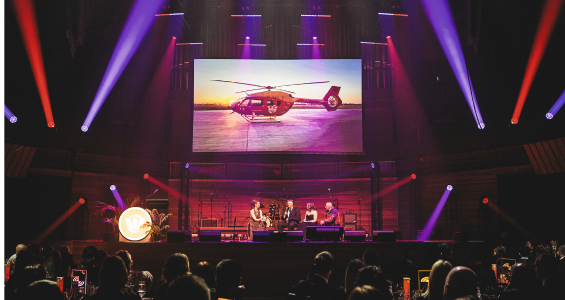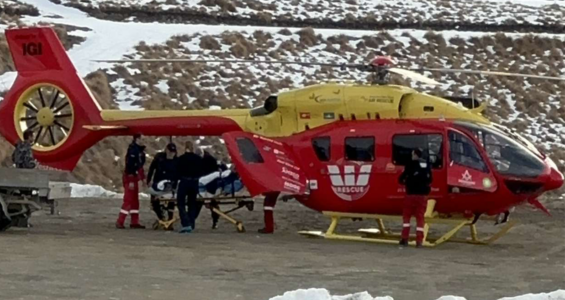Sophia Sturgess is walking Back to Base this year to raise money for the service that saved her after a tramping accident. Here, Sophia tells her story.
During the Canterbury Weekend of 2022, one of our Lincoln Scouts, Annakin, was completing a tramping expedition for his Chief Scout Award, supported by five other Lincoln Scouts aged between 12 and 15 years old. Sharyn and I, as their Scout Leaders, were shadowing them from a safe distance.
On the first day, we hiked up Banks Peninsula to reach the Hinewai Reserve. After spending the night at the Hinewai Reserve hut, we began our return to Akaroa via a different track. We could still see our Scouts a short distance ahead of us.
The Accident
As I walked down the sloped track, my left foot landed firmly on the grass. As I lifted my right foot, my left foot unexpectedly slid to the right. I fell awkwardly, landing on my left side.
In that moment, an unmistakable crack echoed throughout my body. I knew immediately I had broken my leg.
Of course, some curse words slipped out – I couldn’t believe what had just happened.
Sharyn radioed our Scouts, explained there had been an accident, and they needed to return immediately. While waiting for the Scouts, we called for help. Given the patchy cell reception and our location, we opted to use a Personal Locator Beacon (PLB).
When our scouts returned, the first thing I heard was, “Oh… they are not joking!” Later, I learned that they had thought they were participating in a rescue role-play, which we had ironically planned for one of the days during our three-day tramp. Instead, we gave them a real-life rescue experience!
We received a reassuring surprise call from Nikki at the Rescue Coordination Centre (RCCNZ), who provided us with the support we needed. The Rescue Helicopter was dispatched.
Scouts on duty – preparing for the helicopter
Sharyn assigned each scout an important role in preparing for the arrival of the rescue helicopter. Eliot, Alexander, and Ehren went to find the nearest clearing, planning to signal the helicopter using a bright red jumper, a hi-vis vest, and a small reflective mirror. Meanwhile, James, Annakin and Mason stayed behind with the map and communicated with the rest of the Scouts using radios, making notes, while supporting Sharyn and me.
Before long, we heard the unmistakable sound of a helicopter approaching from a distance, and we could hear it coming toward us. I knew it was coming for me, and I felt an overwhelming sense of relief.
The pilots had a general idea of our location, but the thick brush made it difficult to find us. The downwash from the helicopter cleared some of the vegetation, allowing the pilot to finally see us properly. Fortunately, they also spotted our three Scouts nearby and hovered next to them to allow a paramedic to jump off from the skid of the helicopter.
The Stretcher made from tramping packs
When Kath, the paramedic, arrived it quickly became apparent that I couldn’t be winched out due to the dense foliage. The team decided to transport me up the hill to a clearer area, but this would require a stretcher. Ironically, our Scouts had only learned to make various stretchers from another leader in our Scout Group, who is a member of LANDSAR, three months earlier. So, with Kath’s verbal instructions, the Scouts quickly learned how to create a stretcher by joining three rucksacks together, while she attended to me.
After receiving a sedative, I lost consciousness, which allowed Kath to remove my boot, splint and bandage my injury, and prepare me for transport. Once I was ready, I was transferred onto the homemade stretcher, and Kath, Sharyn, and four Scouts carried me up the hill.
The helicopter to hospital
When I regained consciousness, it took me a while to understand where I was and what was happening. They were trying to put the nappy (a harness used for winching when a patient is in a sitting position) under me. I could see Kath trying to explain things to me, but the effects of the drugs caused a high-pitched ringing in my ears, making it difficult to hear and see her properly. Eventually, I realised that she wanted me to hold onto two straps of the nappy and put on a helmet.
Scouts and leaders took the necessary precautions to ensure the area was secure for the helicopter to hover above. My rucksack went up first, followed by Kath and me on the second winch. We were then lifted into the helicopter.
I have a patchy memory of the ride in the helicopter. I remember the panic that washed over me when I realised my cochlear processor was not on my head. Understanding what I was looking for, Kath quickly fetched it from my rucksack and handed it to me.
I was taken to the Christchurch A&E team, where X-rays revealed that my fall had caused three fractures in my left leg and ankle. I required surgery to repair these complex fractures. Now, I am the owner of a rod, a plate, and over 10 screws in my left leg and ankle!
I later learned that after we left, the Scouts and Sharyn managed to detach the rucksacks, had a debrief and continued to walk down the track back to Akaroa. Annakin completed and later received the Chief Scout Award. All the Scouts and Sharyn were also awarded a Bravo badge for their roles in the rescue.
Sophia’s recovery and her Back to Base Challenge
Two and a half years later, while my bones and skin have healed, the pain persists, and I have been diagnosed with Complex Regional Pain Syndrome (CRPS). I had to relearn how to walk, first with crutches and then without them. I had to regain my balance and even relearn how to swim. By November 2023, as a previously good swimmer, it was shocking to discover that I couldn’t kick or swim properly on my first attempt to swim, which upset me greatly. However, I was determined not to let CRPS defeat me.
By last August, as part of the Back to Base challenge, I was just able to manage freestyle and backstroke swimming, along with increasing my walking distance slowly. Though I did complete my Back to Base 2024 challenge, but it was a massive struggle.
Now, on good days, I can swim freestyle and backstroke, and I can walk a bit further distances, but I am learning to pace myself and identify my safe tolerance levels to avoid pushing too hard and experiencing excessive pain. This is why I decided to take on 49 kilometres again!








